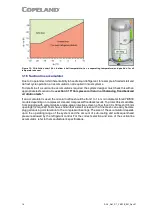
AGL_Ref_ST_YBK1E_EN_Rev01
27
6.1
Qualification of workers
Personnel working on the maintenance, repair and decommissioning of an A2L ref rigerant system
shall be adequately trained. Any work procedure affecting safety shall only be executed by qualified
and trained personnel in compliance with national or other equivalent certification systems.
Examples of such work procedures are:
▪
breaking into the refrigerating circuit;
▪
opening sealed components;
▪
opening ventilated enclosures
…
6.2
Preparation and work procedure
For all A2L ref rigerant systems, a work procedure shall be provided in the preparation stage. All
maintenance personnel and others working at the site shall be instructed on the nature of the work
being carried out.
If any work is to be conducted on the refrigeration systems or any associated parts, appropriate fire
extinguishing equipment shall be provided. Dry powder or CO
2
f ire extinguishers are considered
appropriate. Confirm that appropriate fire extinguishing equipment is available near the work area.
Prior to starting to work on systems containing flammable ref rigerants, safety checks are necessary
to ensure that the risk of ignition is minimized.
Work shall be undertaken under a controlled procedure so as to minimize the risk of a f lammable
gas or vapour being present while the work is being performed.
Avoid working on systems filled with flammable refrigerant in a confined space.
6.3
Disassembling system components
When disassembling system components please follow the main steps described hereunder:
1. For A1 ref rigerant systems (R404A, R407A, R407F, R448A, R449A, R407C, R513A, R134a and
R450A), recover ref rigerant and evacuate system using a recovery unit and vacuum pump. All
the ref rigerant shall be recovered to avoid significant release.
2. For A2L ref rigerant systems (R454C, R455A, R454A and R1234yf ), recover ref rigerant and
evacuate system using an A2L-dedicated recovery unit and vacuum pump. Ensure that the outlet
of the vacuum pump is not close to any potential ignition source and that ventilation is available.
3. Flush system with inert gas (dry nitrogen). Compressed air or oxygen shall not be used for purging
ref rigerant systems.
4. Disassemble components with a cutting tool.
5. Drain, recover and dispose of compressor oil as appropriate.
To disconnect:
▪
Using a pipe cutting tool, cut off the suction and discharge
lines in such a manner that the new compressor can easily be
re-connected into the system.
▪
Heat joint areas 2 and 3 slowly and uniformly until the braze
material sof tens and the tube end can be pulled out f rom the
f itting.
To reconnect:
▪
Recommended brazing material: Silfos with minimum 5 % silver or silver braze used on other
compressors.
▪
Due to the different thermal properties of steel and copper, brazing procedures may have to be
changed from those commonly used.
NOTE: Since the discharge stub contains a check valve, care must be taken not to overheat
it to prevent brazing material from flowing into it.
Figure 17: Tube connecting areas







































